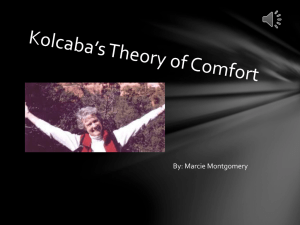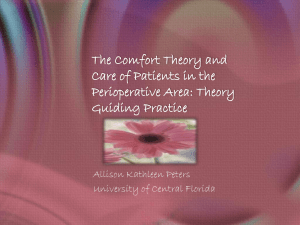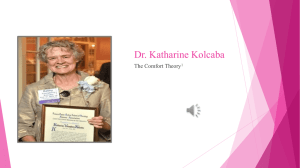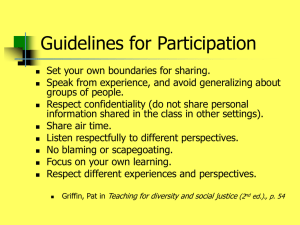Kolcaba`s Theory of comfort
advertisement
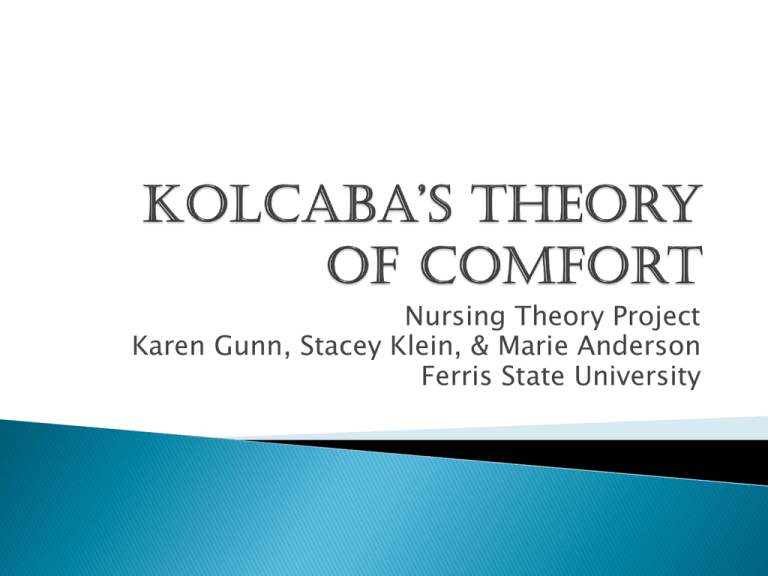
Nursing Theory Project Karen Gunn, Stacey Klein, & Marie Anderson Ferris State University Katherine Kolcaba, Ph.D., RN is a nursing theorist who developed her theory of comfort care while working with dementia patients. Providing comfort has long been a focus for nursing and historically dates back to the early years of professional nursing. She views comfort as both: a verb – an active process a noun – a product or outcome Dowd, T. (2006) Katherine Kolcaba Theory of comfort. In A.M. Tomey and M.R. Alligood (Eds.), Nursing theorists and their work (pp. 726-742) St.Louis, MO: Mosby Elsevier. Enhancing the Patient Experience The principles of Comfort Theory that are relevant to the patient experience include: a. b. c. d. e. each interaction involves the therapeutic use of self. nursing staff identify the holistic comfort needs of patients and family members and design their interaction to meet those needs. nursing staff approach each family member with the intent to comfort and make a personal, culturally relevant connection. nursing staff regularly reassess comfort of patients and family members. nursing staff document comfort levels routinely. http://www.thecomfortline.com/patientexperience Learning Objectives The learner will be able to describe the three basic types of comfort care. The learner will be able to discuss the three areas of comfort care actions. The learner will be able to compare and contrast the art of comfort for the patient and for the care giver. Comfort was traditionally defined as a negative – the absence of or freedom from pain or discomfort. Kolcaba chooses to define comfort in a positive way. “Comfort is the experience of being strengthened through having needs met for any of the three types of comfort” Relief Ease Transcendence Dowd, T. (2006) Katherine Kolcaba Theory of comfort. In A.M. Tomey and M.R. Alligood (Eds.), Nursing theorists and their work (pp. 728) St.Louis, MO: Mosby Elsevier. Kolcaba’s types of comfort can be described as: Relief: the state of a recipient who has had a specific need met. Ease: the state of calm or contentment. Transcendence: the state of in which an individual rises above his or her problems or pain. Dowd, T. (2006) Katherine Kolcaba Theory of comfort. In A.M. Tomey and M.R. Alligood (Eds.), Nursing theorists and their work (pp. 728) St.Louis, MO: Mosby Elsevier. Kolcaba describes four contexts in which comfort is experienced: Physical: pertaining to bodily sensations Psychospiritual: pertaining to internal awareness of self, including esteem, self-concept, sexuality, and meaning in life; the relationship to a higher order or being Environmental: pertaining to external surroundings, conditions, and influences Sociocultural: pertaining to interpersonal, family, and societal relationships Dowd, T. (2006) Katherine Kolcaba Theory of comfort. In A.M. Tomey and M.R. Alligood (Eds.), Nursing theorists and their work (pp. 728-729) St.Louis, MO: Mosby Elsevier. Kolcaba’s taxonomic structure of comfort needs. http://www.thecomfortline.com/taxanomicstructure.html Example: Patient with post-operative surgical pain What are some ways to offer comfort?.......... Example: Patient with post-operative surgical pain Comfort Care Actions Comfort Interventions: pain medications, turning or repositioning, splinting incision, obtaining assessment & vital signs Coaching: reassurance, emotional support, listening, teaching, answering questions Comfort Food for the Soul: filtered lighting, quiet room, calming music, facilitate family coming to the bedside, allow periods of undisturbed rest. Dowd, T. (2006) Katherine Kolcaba Theory of comfort. In A.M. Tomey and M.R. Alligood (Eds.), Nursing theorists and their work (pp. 739) St.Louis, MO: Mosby Elsevier. Discussion Break Divide into groups of 4 people each. Think of some comfort interventions that we offer to our patients. Divide these into the four contexts that we previously discussed: Physical Psychospiritual Environmental Sociocultural http://www.comfortline.com/conceptualframework.html Recipients of comfort measures can be diverse: Patients Family Members Health Care Providers Students Prisoners Workers Older Adults Communities Institutions Dowd, T. (2006) Katherine Kolcaba Theory of comfort. In A.M. Tomey and M.R. Alligood (Eds.), Nursing theorists and their work (pp. 728) St.Louis, MO: Mosby Elsevier. Application of Comfort for Nurses “Comfort Theory proposes that when the comfort of nurses is enhanced, nurses are more satisfied, more committed to the institution, and able to work more effectively. These nurse outcomes result in improved patient outcomes and increased organizational strength.” Drouin, Kolcaba, & Tilton Drouin, C., Kolcaba, K., Tilton, C., (2006). Comfort theory a unifying framework to enhance the practice environment. Journal of Nursing Administration, 36(11), 538. Example: Staff person caring for a patient with morbid obesity What are some ways to offer comfort?.... Example: Staff caring for a patient with morbid obesity Comfort Care Actions Comfort Interventions: willing offers to help, adjust assignments so that the work load is lighter, select patient assignment that is closer geographically, organize equipment and supplies close to hand. Coaching: offer positive feedback, limit setting with the patient, team approach to problem-solving, organizing care tasks to work more efficiently. Comfort Food for the Soul: accepting help and understanding from others, a sense of humor, take breaks away from the unit. Dowd, T. (2006) Katherine Kolcaba Theory of comfort. In A.M. Tomey and M.R. Alligood (Eds.), Nursing theorists and their work (pp. 739) St.Louis, MO: Mosby Elsevier. Discussion Break Take a few minutes to fill out the Comfort Theory Questionnaire. Consider what are some of the things that would make your work environment more comfortable? Remember to consider all of the four contexts we discussed: Physical Psychospiritual Environmental Sociocultural Thank-you for allowing us to share Kolcaba’s Theory of Comfort. We think this theory has a lot of application for nursing practice. Please take one of our survey’s when you leave. It should be returned to us via interoffice mail. The ideas that you have discussed will be collated and distributed back for everyone to share. Karen Gunn Stacey Klein Marie Anderson References Dowd, T. (2006). Katherine Kolcaba Theory of comfort. In A. M. Toomey & M. R. Alligood (Eds.), Nursing theorists and their work (pp. 726742). St. Louis, Missouri: Mosby Elsevier. Drouin, C., Kolcaba, K., Tilton, C. (2006). Comfort theory a unifying framework to enhance the practice environment. Journal of Nursing Administration, 36(11), 538-543. Kolcaba, K. Y., & Kolcaba, R. I. (1991). An Analysis of the Concept of Comfort. Journal of Advanced Nursing, 16(3), 1301-1310. Kolcaba, K. (2008, October 15) Enhancing the patient experience. Retrieved from http://www.thecomfortline.com/patient experience.html Kolcaba, K. (2003, October 27) Taxonomic structure. Retrieved from http://www.thecomfortline.com/taxonomicstructure.html Kolcaba, K. (2002, November 18) Conceptual framework for comfort theory. Retrieved from http://www.thecomfortline.com/conceptualframework.html
